This site is made possible by its sponsors.
Please visit them!
fiber - Thread, yarn, or fabric, such as weaving. The materials used to produce a fiber may be natural (cane, cotton, flax, wool, silk, raffia, rattan, paper pulp [from wood, linen . . .] etc.) or synthetic (nylon, rayon, polyester, etc.)
Also see basketry, feather, leather, textile, and wire.
fiberglass - A light and durable material consisting of a plastic resin which has been reinforced with glass fiber. Sometimes called spun glass.
Examples:

Eva Hesse (American, born Germany, 1936-1970),
Sans II, 1968, fiberglass,
38 x 170 3/4 x 6 1/8 inches (96.5 x 433.7 x 15.6 cm), Whitney
Museum of American Art, NY. See feminism
and feminist art, fluted, Minimalism,
and rectangle.

Eva Hesse, Contingent , 1969, cheesecloth, latex,
fiberglass, installation
(variable) 350.0 x 630.0 x 109.0 cm, National Gallery of Australia,
Canberra.
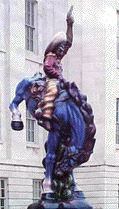
![]()
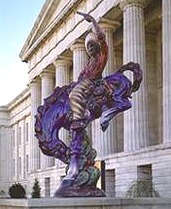
Luis Jiménez (American, born 1940
in El Paso, TX, died 2006 near Taos, NM), [2 views] Vaquero, modeled 1980, cast
1990, cast in fiberglass and epoxy
resin, height 16 1/2 feet,
National Museum of American Art, Washington, D.C. See Chicano
art / Chicana art.

Charles Ray (American, 1953-, lives and works in Los Angeles), Unpainted Sculpture, 1997, fiberglass
cast of a wrecked car, paint,
life-sized, Walker Art Center,
Minneapolis, MN.
Fibonacci sequence or Fibonacci numbers - In their simplest form, a sequence of numbers 1, 1, 2, 3, 5, 8, 13, 21, 34, 55, 89, 144, 233, 337, 610, 987, 1597, 2584, 4181, 6765, etc., in which each successive number is equal to the sum of the two preceding numbers. The fractional version is 1/1, 1/2, 2/3, 3/5, 5/8, 8/13 . . . . Named after Leonardo Fibonacci (1175 - c.1250), an Italian mathematician, they have unusual characteristics with possible applications in botony, astronomy, and psychology, as well as in the arts. (pr. FEE-bə-NAH-chee)
Internet resources concerned with Fibonacci sequence:
Also see fractal, Golden Mean, harmonic sequence, measurement, proportion, ratio, spiral, and volute.
fibula - A pin or brooch used to fasten fabric at the shoulder of togas of ancient Greece and Rome. They were often of decorative design. Some are obvious precursors to the safety pins of today. Contrary to persistent misinformation, no fibula is a small lie.
(pr. FIB-yə-lə)
Examples:

Greece, (probably Thessaly, possibly Pherai
or Philia), Fibula, end of the 8th century BCE,
bronze, 5.2 x 8 cm, George Ortiz
collection. See Greek art.

English, The Market Rasen Brooch,
Iron Age, 1-75 CE, gold fibula, British Museum, London.
The shape of the head of this fibula seems to have been made to resemble a grotesque bird. It was made and worn by people living just before and after the Roman Conquest of southern England in 43 CE. See English art.
![]()
![]()
Roman, end of the 3rd century CE,
Fibula
from Osztropataka, gold,
length 9.8 cm, weight
71.8 g, Kunsthistoriches Museum, Vienna.
Also see chiton, Greek art, himation,
jewelry, mantle,
and Roman art.
field and field of view - A background area or an entire physical plane, often of one color and/or texture. Also, a sphere of activity, or a content, or a discourse. And, the area in which an image is rendered by the lens of an optical instrument; also called field of view, which can be any sort of shape and size. A wide field of vision might be panoramic, and a narrow one "long" or "telephoto," high and wide might be "fish-eye," "close-up," a "blow-up," or an "enlargement." Extremely narrow fields of view are routinely achieved with microscopes and telescopes. The latter include the sort of lenses used by satellites that make photographs of small areas of the earth's surface for military, scientific, and commercial purposes. A U.S. Navy Lieutenant, Joe Dalton, is credited with being the first, in 1998, to use a term for this extremely narrow field of view: the "soda-straw effect."
In graphic design and computer terminology, a field is often a page, and if its orientation is vertical it is called portrait, and if horizontal it is called landscape.
Also in computer terminology, a field is an element of a database record in which one piece of information is stored.
Also see depth of field, field loss, heraldry, pan, panning shot, point of view, and tracking shot.
field loss - Also known as tunnel vision, this visual malady is a reduced visual range due to injury or disease.
fifth dimension - Metaphysical — based on speculative or abstract reasoning, and interpreted variously as: highly abstract or theoretical, or immaterial, or as supernatural.
Also see metaphysics.
![]()

![]()
fig leaf - A stylized representation of a leaf from a fig tree or shrub used especially to conceal the genitalia depicted on sculptures of male nudes. Although fig leaves were originally deployed as a censoring gesture in favor of modesty, contemporary audiences, are increasingly more embarrassed by their continued use.
A reference to fig leaves often connotes something that conceals or camouflages insufficiently.
Examples:


Apoxyomenos
(Scraper), Roman
copy of an original bronze
by Lysippos, a Greek sculptor
who worked c. 325 BCE,
marble, height
82 inches, with fig leaf, Vatican. Apoxyomenos, a gymnast, is
portrayed scraping dusty oil from
his right arm with a tool called a strigil. Lysippos provided
the foundation for Hellenistic sculpture.
The
sculpture photographed without fig leaf. See Hellenistic.
After Leochares (Roman copy of a Greek work of c. 330 BCE),
Apollo Belvedere, marble,
height 7 feet 4 inches,  Vatican Museum.
Vatican Museum.  This sculpture was found late in the
fifteenth century, the fig leaf added later. Thumbnails here
show the
ruins of its pubic area
This sculpture was found late in the
fifteenth century, the fig leaf added later. Thumbnails here
show the
ruins of its pubic area with and without
a fig leaf. Here are photos of the entire
sculpture, as "improved" by the addition of fig
leaf and hands, and another with the fig leaf and hands not added.

Francis Picabia (French, 1879-1953), The Fig-Leaf, 1922, household paint on
canvas, 200.0 x 160.0 cm,
Tate Gallery, London. Picabia made The Fig-Leaf in protest
at the rejection of two of his works from an important exhibition
in Paris. To mock the conservatism of the organisers, he painted
over a mechanical image of a turbine brake that had caused a
scandal the previous year. His new design quoted the pose of
a painting by Ingres titled Oedipus and the Sphinx, but
included a fig-leaf (the French say "vine leaf") as
a reference to censorship.
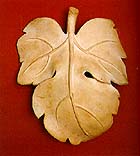
English, D. Brucciani & Co.?, Fig Leaf,
c. 1857, plaster
cast, length
19 inches (48 cm), Victoria and Albert Museum, London. This museum
has exhibited an 18 foot tall plaster cast of Michelangelo's
David since Queen Victoria received it
as a gift from the grand duke of Tuscany in 1857. Because the
queen "was so shocked by the nudity," this fig leaf
was "hung on the figure using two strategically placed hooks"
during her visits, and was reportedly placed on David
on the occasion of visits by other royal ladies until 1953. The
leaf is currently displayed in its own case attached to the back
of the plinth of the figure.
Attempts to cover up David have a much longer history actually. In the middle of the 16th century, Italian guardians of public morality insisted on adding a metal loincloth made of 28 fig leaves. In 1995, religious authorities in Jerusalem declined Florence's gift of a full-scale replica of David unless its genitals were similarly concealed.
Artist Niki de Saint Phalle (French-American, 1930-2002), was a teenager in New York in the mid-1940s. On her web site, her biography says, "Throughout her youth she continually questions authority and is sent to a succession of schools. At the Brearly School, she becomes interested in the work of Edgar Allan Poe, Shakespeare, and the Greek tragedies. Discovers Russian authors; passionately reads all the Dostoevsky. She acts in school plays and begins to write her own poetry and plays. She is dismissed from Brearly for painting the fig leaves red on the school's statuary."
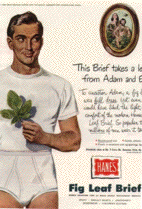
American, detail: Hanes Fig Leaf Briefs, magazine advertisement,
1950.

Wired magazine published an article
about "Canada's Thought Police," describing the impact
Canada's vague pornography
laws were having on operators of computer bulletin boards, March
1995. To mask the genitalia of Michelangelo's David, the
story's illustrator chose a maple leaf instead of a fig leaf,
referencing the maple leaf's symbolism
in
 Canada.
See Renaissance.
Canada.
See Renaissance.
Also see aidoion, censorship, erotica and erotic art, feminism and feminist art, First Amendment rights, gender issues, iconophobia, love, nude, obscene, pornography, ugly, sex, transgressive art, and voyeurism.
figuration - An act of representation in figures. forming something into a particular shape.
Also see figure, figurative, figure-ground, statue, and statuette.
Figuration Libre - A twentieth century European art movement. [More soon!]
figurative - Describes artwork representing the form of a human, an animal or a thing; any expression of one thing in terms of another thing. Abstract artwork is the opposite of figurative art in certain ways. Roy Lichtenstein made a series of images of a bull, demonstrating this kind of range in ways to approach figuration and abstraction ― beginning with the most highly figurative version, and proceeding through stages to the most abstract version:
![]()

Roy Lichtenstein (American, 1923-1997), the six prints in the "Bull Profile Series,"

![]()


![]()


and Bull
VI, 1973, each is a linoleum
cut on paper, and each is 68.5
x 89.0 cm, Tate Gallery, London. See Pop Art and profile.
Quote:
Also see emblem, figure, metamorphosis, symbol, and trope.
figure-ground - In two-dimensional
works of art, the visual unity,
yet separability, of a form and its
background. Certain alternating figures may help to convey the potential confusion resulting from ambiguity in the figure-ground relationship. One is an alternating figure commonly called a "magic cube": the transparent cube in the center below. Which of its sides is nearest to you? Is it the one made solidly green on the cube to the left or is it the green side on the cube to the right, or is there no nearest side at all?

Here is a fully open-sided version produced with a high degree of realism. The two points where the linear edges must overlap have been purposely confused. This figure produces an even more jarring figure-ground dilemma than do the drawings above. This optical illusion might be interpretted as humorous or upsetting.
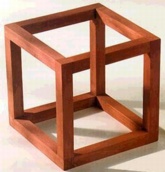
Also see figuration and figurative.
filbert - A brush with a conical shape.
file - A steel tool with a grooved surface used to shape, cut, or smooth materials by abrasion. A file which has a surface both toothed and perforated is a rasp.
Also see metal, plastic, riffler, surform, and wood.
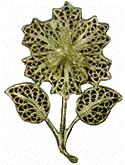
filigree - A delicate, lacelike, and intricate openwork ornament, usually made from thin wire.
Example:
Russian, Jewelry Casket. c. 1790, silver filigree, gold, pearls, rubies, beryl, and quartz. Pavlovsk State Museum, Russia.
Also see gauge, gem, jewelry, and sheet metal.
filler - A powdered or ground substance added to a paint or sculpture material to give extra bulk or body. Fillers for resin also make the material opaque.
Also see aggregate and extender.
filling compound - A paste which can be spread into a break or indentation in a surface. The compound can be filed down and smoothed when hard.
Also see plaster.
film - See animation, cellophane, cinema, frisket, movement, negative, time, and video.
filter - A porous or permeable material or device which prevents some things from passing through it, and allows others passage. Filters are used to separate or refine some particles, liquids, gases, or light. Most light filters, such as might be used in photography or in light projection are tinted, but some are polarizing. Acting like seives, some filters are screens, or act like them. Particles of one size or smaller will pass through a screen with openings of a consistent size, while particles of any larger size cannot. Such a filtering screen is useful in removing impurities from paints, for instance, or in separating sizes of sand.
Also see clean up, day for night, lens, moiré, plaster trap, and trit.
fin de siècle - French for "end of the century." During the twentieth century, this referred to the art of the 1890s — especially the art of aestheticism and Art Nouveau — which is sometimes known as "decadent art." An artist who epitomizes this period is Aubrey Beardsley (English, 1872-1898). When used in art criticism fin de siècle often connotes the idea of a style or movement on the decline. As the end of the twentieth century drew near, this term has been used increasingly to refer to the 1990s. The French for "beginning of the century" — début de siècle — while more rarely used, has been used both for the first decade of the 1900s, and inevitably for that of the 2000s.
(pr. fan duh see-EK-lə)
Examples:
 Sir
Thomas Malory (British, 15th c.), Author; Aubrey Beardsley (British,
1872-1898), Illustrator; London: J. M. Dent and Co., 1893, Publisher,
Morte d'Arthur, 1893, printed book; 12
pts. : ill. , pl. ; 26 cm, Metropolitan Museum of Art, NY.
Sir
Thomas Malory (British, 15th c.), Author; Aubrey Beardsley (British,
1872-1898), Illustrator; London: J. M. Dent and Co., 1893, Publisher,
Morte d'Arthur, 1893, printed book; 12
pts. : ill. , pl. ; 26 cm, Metropolitan Museum of Art, NY.
Illustrated:
Aubrey Beardsley's design for the printed paper wrapper from
Part I. See illustration.

Aubrey Beardsley, Messalina and her Companion, 1895, pencil, ink
wash and watercolor on paper,
27.9 x 17.8 cm, Tate Modern, London.
![]()
![]()
Aubrey Beardsley, The Dream, 1896, pen
and black ink, J. Paul Getty Museum,
Malibu, CA.
Related resource:
Also see art for art's sake and Symbolism.
findings - Accessories used for completing jewelry, such as clasps, hinges, pins, posts, etc.
fine art - See art and high art.
Quote:
fine motor - Small movements, especially in the hands. Small motor skills typically develop at a certain pace in childhood, following and alongside the development of gross motor skills.
fine silver - Silver that is 99.9 per cent pure; has a higher melting point than sterling silver.
Also see temperature.
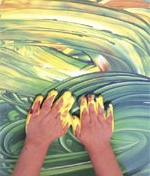 finger paint or fingerpainting
- Finger paints are formulated to be applied
and manipulated by the hands. Rubbing the paint on the paper is varied by using different parts of the hands (fingertips, nails, knuckles, palms, wrists, etc.) and arms (forearms and elbows).
This process is called fingerpainting,
typically done on a large sheet of glossy white
paper, strong (60-pound is good), coated on one or both sides, and non-absorbent, having a smooth, bright
surface that resists running and bleeding.
finger paint or fingerpainting
- Finger paints are formulated to be applied
and manipulated by the hands. Rubbing the paint on the paper is varied by using different parts of the hands (fingertips, nails, knuckles, palms, wrists, etc.) and arms (forearms and elbows).
This process is called fingerpainting,
typically done on a large sheet of glossy white
paper, strong (60-pound is good), coated on one or both sides, and non-absorbent, having a smooth, bright
surface that resists running and bleeding.  Although
done by artists of all ages, today fingerpainting is
commonly associated with painters at the early-childhood level.
Although
done by artists of all ages, today fingerpainting is
commonly associated with painters at the early-childhood level.
Finger paints can be purchased (thickened, in jars, and washable), or they can made from other ingredients. If you have tempera, all you need to do is to thicken its consistency by adding cornstarch (also known as cornflour) — better in powder (cooking ingredient) than in liquid form (laundry supply). A pint of paint is improved with the addition of a half-cup of cornstarch. A glossy finish will result if you add a tablespoon of glycerine per quart.
The painter above may be oblivious to the paint she gets on her face and clothing, so someone might have helped her roll up long sleeves, and put on a smock. If she is accompanied by a group of other painters, assistants might also prepare for cleaning up when they're all done by spreading old newspapers on the floor near a sink, placing a bucket half-filled with soapy water on the papers. Painters can clean some of their hands and forearms in the bucket before finishing up at the sink. Plenty of towels should be accessible too.
Fingerpainting probably originated in pre-historic play with mud and other sorts of muck. It was done in 8th century China, as well as in ancient Etruria and Herculaneum. Ruth Faison Shaw (American, 1888-1969) developed a modern fingerpainting technique (sometimes called the "Shavian technique") in the 1920s, likening it to dance, and popularized it in the 1930s, 40s, and 50s. Shaw never began a painting with an idea in mind, preferring to let her subconscious imagination take over. Shaw was also an advocate of progressive education and a pioneer of art therapy.
Example:

Gao Qipei (Chinese, 16721734), Qing dynasty, Quail, c. 1730, leaf from an album of finger paintings, 11 3/4 x l3 3/4 inches (30 x 35 cm), Herbert F. Johnson Museum of Art, Cornell U, Ithaca, NY.
Related link:
The Shaw School & Studio, Durham, NC. Bryan Carey teaches Ruth Faison Shaw's fingerpainting technique.
Also see body art.
finish - Something that concludes, completes, or perfects, especially the last coating or treatment of a surface, or the surface texture resulting from such a coating or treatment. A finish in this sense might be described as matt, semi-gloss, or glossy, lustrous, luminous.
Also, a material used in finishing or surfacing.
And, the point at which an artist decides to stop working on an artwork. A finished work could also be called completed or done, or ready to be displayed.
Quote:
Also see abrasive, encaustic, finial, general to particular, glaze, lacquer, moiré, polish, polyurethane, shellac, varnish, and wood.
fire - See firing.
Also see temperature.
fire brick - A brick made of clay that withstands high temperatures in a kiln.
Also see refractory.
fire gilding - A process
for the gilding of metal
— usually copper, copper alloy,
or silver — also known as mercury
gilding, and as ormolu.
Powdered gold (also known
as moulu) mixed with mercury is applied to the surface of the metal as a paste and then fired.
The mercury evaporates as highly toxic fumes, and the gold is fixed. This surface must then be burnished.
Example:
![]()

Moderno (Galeazzo Mondella?) (Italian, working
1490 - 1540), Sacra Conversazione, c. 1510, silver, fire gilding, 13.9 x 10.2 cm,
Kunsthistoriches Museum, Vienna. See sacra
conversazione.
fireplace - See mantel or mantelpiece.
firing - A process of applying heat to make hard pottery in either an oven or an ovenlike enclosure called a kiln. Also the means of fixing colors to ceramic surfaces.
Also see glaze, polymer clay, pyrometric cones, and temperature.
firing cracks - Cracks appearing in a cooling material, caused by the tension from the different rates of its shrinking. For example, in clay after its firing, or in metal after it has been cast.
Also see temperature.
firing skin - The hard, smooth surface of various fired clays.
First Amendment rights - The First Amendment to the U.S. Constitution guarantees freedoms of religion, speech, and the press, the right of peaceable assembly, and the right to petition the government for a redress of grievances. In 1989 the U.S. Supreme Court ruled that burning the American flag in public to protest government policies is a right protected by the First Amendment. Similarly, one contemporary artist's work in which the flag was placed on a floor, and another's in which it was placed in a toilet have been guaranteed protection under this law's guarantee of freedom of speech.
Freedom of expression is not without limits. A classic case: a person falsely shouts "Fire! Fire!" in a crowded theater. If an ensuing panic, some people may be seriously injured. Courts have ruled that the shouter cannot defend the triggering of panic as protected by freedom of expression. Similarly there are justifiable laws against defamation, slander, perjury and other injurious false expressions.
In early 2006, twelve caricatures (first appearing in the Danish newspaper Jyllands-Posten the previous September) satirizing Mohammad triggered protests, some violent, among Muslims of many nations. Muhammad was portrayed in one of the drawings wearing a turban in the shape of a ticking bomb. He stands at the gates of heaven, arms raised, saying to men who look like suicide bombers, "Stop, stop, we have run out of virgins." The newspaper justified its action by saying it was exercising its freedom of expression. It could be argued that an understanding of Islamic culture, or of humanism, would preclude the publication of such drawings as these as irresponsible. (See iconoclasm, transgressive art, and xenophobia)
Quotes:

Related links:
The American Civil Liberties Union (ACLU) is an organization in the United States of America that deservedly call's itself the nation's guardian of liberty. It works daily in courts, legislatures and communities to defend and preserve the individual rights and liberties guaranteed to every person in the United States by the country's Constitution and laws. Its mission is to conserve America's original civic values ― the Constitution and the Bill of Rights.
It
works to extend rights to segments of our population that have traditionally been denied their rights, including Native Americans and other people of color; lesbians, gay men, bisexuals and transgendered people; women; mental-health patients; prisoners; people with disabilities; and the poor. If the rights of society's most vulnerable members are denied, everybody's rights are imperiled. ![]()

![]()
Free Press is an American nonpartisan organization working to increase informed public participation in crucial media policy debates, and to generate policies that will produce a more competitive and public interest-oriented media system with a strong nonprofit and noncommercial sector.
Also see censorship, Center for Arts and Culture, culture jamming, erotica and erotic art, feminism and feminist art, fig leaf, nude, obscene, pornography, and xenophobia.

fish-eye lens - A wide-angle photographic lens that views an extremely high and wide area to an angle of about 180 degrees, and that (when uncropped) gives a circular image in which subjects seen at the center typically appear nearer than those seen at the outer edges. A fish-eye lens has a highly curved convex front surface.
Examples:
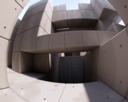
Alex McLeod (American, contemporary), An
Architectural Space?, c. 2003, digital image rendered
with Brazil
r/s software.
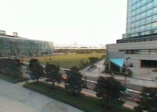
![]()
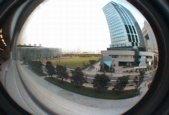
An urban landscape photographed both with
a normal lens and with a fish-eye lens. The edges of the second
shot reveal some of the room from which the picture was taken.
Also see anamorphosis, anamorphic art, distort, dome, pan, panning shot, panorama, teleidoscope, and wide-angle lens.
Five Dynasties - A Chinese dynastic period which lasted 907 - 960.
An example of art of this period:

China, Zhejiang province, probably the vicinity
of Shanglinhu, Bowl, Five Dynasties period (907-960),
10th century, stoneware
with carved and incised
design under celadon
glaze (Yue ware), height
4 3/8 inches, Metropolitan Museum of Art, NY.
fix - To place something (perhaps a pigment) in a secure or firm position.
Also see fixative.
fixative - 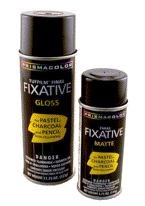 A thin varnish,
natural or synthetic,
that is sprayed over charcoal,
pastel, oil pastel, oil crayon, pencil, and other drawing mediums, as well as photograps, maps, signs, and unfired ceramics, to protect them from smearing, finger prints, and detatching from a supporting surface (paper, etc.) All or some fixatives will alter the original colors
slightly. The best are colorless, non-yellowing, and flexible. Some fixatives permit a medium to remain workable, while others lock it into its position. Some permit the choice of a glossy or a matte finish. Manufactured fixatives are most often available in aerosol cans. Common hairsprays work well as student-grade fixatives. (pr. FIX-ə-təv)
A thin varnish,
natural or synthetic,
that is sprayed over charcoal,
pastel, oil pastel, oil crayon, pencil, and other drawing mediums, as well as photograps, maps, signs, and unfired ceramics, to protect them from smearing, finger prints, and detatching from a supporting surface (paper, etc.) All or some fixatives will alter the original colors
slightly. The best are colorless, non-yellowing, and flexible. Some fixatives permit a medium to remain workable, while others lock it into its position. Some permit the choice of a glossy or a matte finish. Manufactured fixatives are most often available in aerosol cans. Common hairsprays work well as student-grade fixatives. (pr. FIX-ə-təv)
A related link:

flammable - Easily combustible. Easily ignited by a flame or spark, high temperatures, etc. Highly flammable substances should be well isolated from other substances, stored and disposed of in sturdy, nonflammable containers.
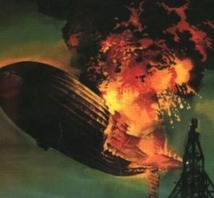
On May 6, 1937, the giant German
blimp Hindenburg exploded over a New Jersey field, killing
thirty-five passengers and crew. The "Zeppelin airship"
was about to land at the Lakehurst Naval Air Station after a two
and a half day trip from Frankfurt, Germany. It was 300 feet above
the ground when it burst into flames. A likely cause: the flammable
hydrogen keeping the ship afloat had ignited after it began to
leak. The airship was designed to use the nonflammable gas helium.
But since helium was in short supply, the company decided to risk
using a hazardous substitute.
BIG mistake.
Prevent accidents by being knowledgeable about the flammability of the materials around you. Be prepared to deal with fires and other hazards by keeping a range of health and safety information and equipment near at hand.
Common extinguishing agents are water, carbon dioxide, dry chemical, "alcohol" foam, and halogenated gases (Halons). It's important to know which extinguishers can be used so they can be made available at the worksite. It is important to know which agents cannot be used, since an incorrect extinguisher may not work or may create a more hazardous situation. If several materials are involved in a fire, an extinguisher effective for all of the materials should be used.
Other resources concerning flammability in the visual arts:
Also see ASTM International (American Society for Testing and Materials), Material Safety Data Sheet (MSDS), paper, toluene, toxic, and wood.
flamboyant - Literally, flamelike, flaming. Applied to aspects of late Gothic style, especially architectural tracery. The noun form is flamboyance. If a quality of a person or thing's flamboyance is self-importance, claiming unjustified distinction, then the better adjective might be ostentatious, or worse: pretentious.
(pr. flam-BOY-ənt)
Examples of flamboyant architecture, in the first sense:

![]()
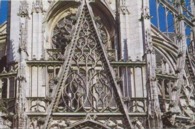
French, Rouen, St. Maclou, 1432-1500.
Detail
of flame-like motifs in
the stone tracery over the
main entrance.
![]()
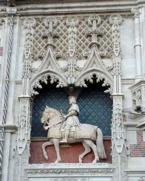
![]()
French, Castle at Blois, an equestrian
statue of King Louis XII in a facade built in the flamboyant
style, c. 1500. See equestrian
statue.
Also see flourish, paraph, baroque, rococo, and theater.
flaming - A process for finishing and hardening a wax model by passing a candle flame over the surface. Also refers to sending antagonizing email messages.
Also see encaustic.
![]()
![]()
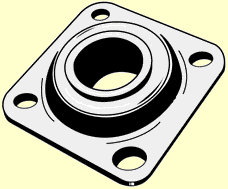
![]()
flange - A protruding rim, edge, rib, or collar, used to strengthen an object, hold it in place, or attach it to another object. Often simply a metal ring which flares at its base so it can be screwed to a flat surface; and when a rod is inserted into the flange, it is held at right angles to the surface.
flashing - The thin rough-edged projections on a casting made from a piece mold from which the cast metal has seeped or forced its way into seams, joins or cracks in the mold. On the exterior of a cast these are generally sawn off and filed down.
Also see potato.
![]()
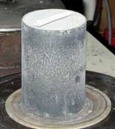
![]()
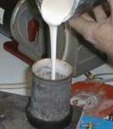
![]()
flask - The container used for making a mold. In the case of the one pictured here, the flask is a steel cylinder — open at each end — in which an investment has been poured over a wax model to fill the flask to its rim in the lost-wax casting process.
flat - The quality of a smooth, even, broad surface; a surface without curvature; especially a horizontal one. Also, lacking variety in tint or shading; uniform. Not glossy; mat (also spelled matte). And, it may refer to a flat-shaped brush. Although it is an oversimplification of their position, modernist artists and artwriters of the 1960s and early 1970s agreed that the essential characteristic of painting was its flatness, a point of view especially formulated by the critic Clement Greenberg (American, 1909-). This led to post-painterly abstraction on the one hand and to minimalism on the other.
An image that takes on flatness in an unusual way:

Maurits Cornelis Escher (Dutch, 1898-1972),
Balcony, 1945, lithograph,
11 3/4 x 9 1/4 inches (29.7 x 23.4 cm), National Gallery of Art,
Washington, DC. In the center of this picture of a hillside town,
Escher said he tried to break up the paper's flatness by "pretend[ing]
to give it a blow with my fist at the back, but . . . the paper
remains flat, and I have only created the illusion of an illusion."
See illusion, optical
illusion, and perspective.
Also see Abstract Expressionism, camera-ready, formalism, French curve, mirror, Op Art, and Pop Art.
flatbed scanner - An image-capture device — scanner — resembling a photocopy machine. The object to be scanned is placed face-down on a glass plate. The CCD array passes beneath the glass.
flat chisel - A chisel with a straight cutting edge used for finishing and shaping in wood or stone carving.

flat file - A drawer system which is especially suited for the storage of large, flat objects, such as sheets of paper, drawings, and prints. Also see bin and stack tray.
flattery - To compliment excessively. Often flattery refers to such compliments given insincerely, especially in order to win favor or gratify someone's vanity. Also see mirror.
![]()
![]()

![]() [Someone suggested ArtPage define flatulence. We doubt this is appropriate for an art dictionary. However, for those who will find such information useful, "flatulence" refers to an emergency vehicle that picks up a person who has been run
over by a steamroller.]
[Someone suggested ArtPage define flatulence. We doubt this is appropriate for an art dictionary. However, for those who will find such information useful, "flatulence" refers to an emergency vehicle that picks up a person who has been run
over by a steamroller.]
![]()
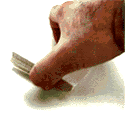
![]()
flipbook or flip book - A small book consisting of a series of pictures that give the illusion of continuous movement when the thumb is placed so that the pages will flip past at a steady pace. The example shown here was produced with a stack of 3 x 5 inch index cards. Also see animation and kinetic.
float - A decorated exhibit or scene mounted on a mobile platform and pulled, carried, or driven in a parade. (pr. floht)
Examples:
Jean Boch (Belgian, 1545-1608), author;
Pieter van der Borcht (Dutch, 1545-1609), engraver; Anterpíae:
Ex Officina Plantíníana, 1595, publisher, Descriptio Pbvlicae Gratvlationis, Spectacvlorvm
et Lvdorvm, in Aventv Sereniss : Principis Ernesti Archidvcis
Avstriae Dvcis Bvrgvndiae ... Belgicis Provinciis a Regia  Maiestate Catholica Praefecti, an. 1594
... / Omnia a Ioanne Bochio ... Conscripta., 1595, printed book;
174 , [2] p. : including 34 engraved plates , (4 double) ; 38
x 26 cm, Metropolitan Museum of Art, NY. This lavishly illustrated
volume describes the 1594 triumphal entry of Archduke Ernst of
Austria into Belgium.
Maiestate Catholica Praefecti, an. 1594
... / Omnia a Ioanne Bochio ... Conscripta., 1595, printed book;
174 , [2] p. : including 34 engraved plates , (4 double) ; 38
x 26 cm, Metropolitan Museum of Art, NY. This lavishly illustrated
volume describes the 1594 triumphal entry of Archduke Ernst of
Austria into Belgium.
Illustrated:
"Schema Elephanti" from the festival book of Ernst,
Archduke of Austria. (page 113)

American, Alabama, members of Albertville
High School's 2002-03 Freshman Class, graduating in 2006, Aggies,
BBQ the Bulldogs, homecoming float, 2002, mixed
media on flatbed trailer, as pulled by pickup truck. Nearly
every high school and college in America has a football team.
Each of those teams designates one game each year to be its "homecoming
game." In addition to the contest on the gridiron is a competition
between the school's classes to produce the best float to parade
around the field at half-time. The winning float is usually produced
either by the school's juniors or seniors. ArtPage believes the
freshmen Aggies of 2002-2003 produced the best homecoming float
in the entire USA this year.
floodlights - The kind of lighting Noah used for the ark.
flourish - To grow luxuriantly; to thrive. Or, to succeed. Also, a dramatic movement or gesture; panache. In art, this is often a curvilinear ornamentation or embellishment, especially in calligraphy or handwriting. (pr. FLəh-rəsh) Examples of flourishes in the last sense:

Thirteen calligraphic capital
letters drawn
with flourishes, and
some words drawn with flourishes
in their capital letters, descenders, and an ampersand.
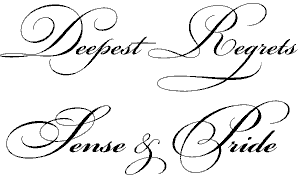
Also see curve, flamboyant, ligature, line, paraph, theater, and typography.
flow - To melt. Also see temperature.
flubdub - A dingbat.
fluorescence and fluorescent lamps - The emission of electromagnetic radiation, especially of visible light, stimulated in a substance by the absorption of incident radiation and persisting only as long as the stimulating radiation is continued. Also, the property of emitting such radiation, or that radiation itself. Various things can be fluorescent, most commonly lamps in the form of tubes whose inner wall is coated with a material that fluoresces when an electric current causes a vapor within the tube to discharge electrons. Also see incandescence, infrared reflectography (IR) and reflectogram, kelvin, neon, radiograph, stroboscopic, ultraviolet, and x-ray.
fluorescent colors -Also called day-glo colors or DayGlo colors colors and neon colors, fluorescent colors are especially bright, clean materials which can be much brighter than conventional colors. They were first developed in the 1930s, finding their way into magic shows, stage shows, and movie posters. They contain certain dyes and resins that produce colors far brighter than traditional pigments, and that had the unique effect of "glowing" under ultraviolet or black light. Fluorescent colors are exceptionally bright under many different conditions, including indoor lighting, low light outdoors, and in limited visibility areas. Studies have shown that fluorescent colors are noticed first. They grab the attention of the observer. Fluorescent colors are widely used to get attention, focus attention on an object, warn people of a potentially hazardous situation, get an object, person or situation noticed, etc. They are commonly used for traffic cones, detergent packaging, tennis balls, fishing lures, etc., and can be found in a wide range of media, including oil and acrylic paints, inks, dyes, markers, crayons, etc. (pr. flə-REH-sənt)
Related resources:
Also see glitter, graphic design, ink, iridescence, light, luminous paint, opalescent, paint, signage.
flute, fluted, and fluting - Grooves or channels which are roughly semi-circular in cross-section, found repeated vertically in columns, pedestals and pilasters, but also used in frames and other moldings.
Examples:
Egypt, (4th-5th Dynasties, c. 2575-2323 BCE), Headrest with Fluted Pedestal, calcite (Egyptian alabaster, or onyx-marble), 9 x 7 7/8 x 3 3/4 inches (22.9 x 19.9 x 9.3 cm), Michael C. Carlos Museum. See Egyptian art.

Persia / Iran, Fluted bowl, 522-405 BCE,
Achaemenid period, reign of Darius I or II, gold, height
4.4 inches (11.1 cm), Metropolitan Museum of Art, NY.
![]()
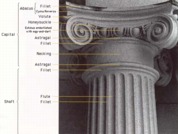
![]()
Ionic
capital and its fluted shaft, with each of its parts labeled.
See Ionic, Corinthian, and shaft.

Eva Hesse (American, born Germany, 1936-1970),
Sans II, 1968, fiberglass,
38 x 170 3/4 x 6 1/8 inches (96.5 x 433.7 x 15.6 cm), Whitney
Museum of American Art, NY. See feminism
and feminist art, Minimalism,
and rectangle.
Judith Turner (American photographer, contemporary, active 1972-), Fluted Column #2, PhotoArts Gallery, New York, NY. See column.
Also see bevel, carve, chamfer, corrugate, curve, dado, dent, edge, emboss, fold, Ionic, pleat, relief, repoussé, and rugosity.
flux - A chemical used to clean oxides and other impurities from metal to assist fusion when metals are welded or brazed. In ceramics, flux causes or promotes melting. Also see deoxidize and Fluxus.
flying buttress - See buttress.
fly-whisk - In Hindu art the fly-whisk or fan is one of the attributes of the god Shiva, especially in Indonesia. But Shiva is not the only figure to hold this attribute. It occurs frequently as an attribute of other Hindu and Buddhist deities. Heavenly servants often have a fan or fly-whisk to cool their master and to keep away insects.
https://inform.quest/_art